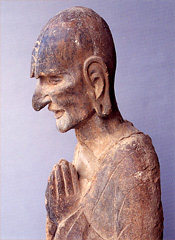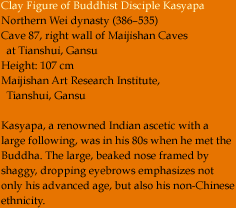 |
|
 |

Go, Monks, preach, the Noble Doctrine . . . let not two of you go in the same direction. — Buddha, Vinaya-pitaka, II Alongside the merchants and diplomatic envoys of the Silk Road traveled disciples of the Buddha, obeying his exhortation to spread his teachings. The political turmoil of the time offered Buddhist missionaries, many of Indian, Central Asian, or even of nomad stock, opportunities to convert local rulers. In exchange for the monks' services as magicians, fortune tellers, and political, military, and diplomatic advisers, Buddhism gained powerful patrons willing to support image making, cave temples, and translation centers. In these centers, teams of non-Chinese and Chinese monks collaborated on the translation of Buddhist sutras (scriptures) in Indian and Central Asian languages into Chinese. Huge numbers of the population entered religious orders. The monastic ideal, indeed, became an important theme in Buddhist art. Figures of Ananda and Kasyapa in simple monastic dress, such as those shown here, often flanked the main images, as if a reminder of the vital role of monks in the spread of Buddhist teachings. |
||||